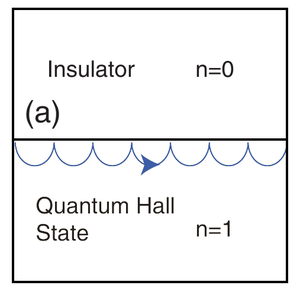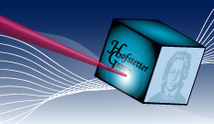Topological phases
The study of topological properties of matter is a relatively new, but fast developing field of research in condensed matter physics. The fact that the recent Nobel Prize in Physics was awarded to D. J. Thouless, F. D. M. Haldane and J. M. Kosterlitz (2016) for theoretical discoveries of topological phase transitions and topological phases of matter speaks here better than words. Scientists have high hopes in possible applications of topological effects, e.g., for quantum computing, and therefore a lot of effort is put into the development of this branch of physics.
One of the reasons why topological phases are so important is the explanation of phase transitions in low-dimensional systems, in which no spontaneous breaking of continuous symmetry at finite temperature can occur, as was shown by N. D. Mermin and H. Wagner [1]. This poses a significant problem for the theoretical description of many systems, e.g., thin films of superfluid. This issue can be addressed by considering the possibility of topological phase transitions, in which no symmetry is spontaneously broken.
An importantexample for topological states of matter are topological insulators. They are interesting due to their peculiar intrinsic properties, since they are insulating within their bulk but exhibit robust, conducting states at the edges (surface), Fig. 1. They are very closely related to the (anomalous) quantum Hall effect as well as the quantum spin Hall effect in solid-state physics. However, it turns out that one can also observe topological properties without magnetic field. In optical lattice experiments with ultracold atoms it is already possible to achieve this by designing artificial gauge fields through shaking of the lattice [2] or laser-assisted tunnelling [3]. Thus one can create intriguing quantum states with non-trivial topological index.
Interesting questions arise when we investigate topological states in cold atoms theoretically, supported by the powerful tool of dynamical mean-field theory [5,6]: What are the properties of strongly interacting topological insulators? What is the effect of disorder? How does an external confinement potential influence the edge states? How can we realize topological states by periodic driving?


Fig. 1. (Left panel) The interface between a quantum Hall state and an insulator has a chiral edge mode. The skipping cyclotron orbits. Figure obtained from Ref. [4]. (Right panel) Single particle spectral functions in band insulating (upper) and quantum spin Hall (lower) regime. One can see edge modes crossing the the bulk gap in the quantum spin Hall state. Figure taken from Ref. [6].
[1] N. D. Mermin, and H. Wagner, Phys. Rev. Lett. 17, 1133 (1966).
[2] N. Fläschner et al., Science 352, 1091 (2016).
[3] M. Aidelsburger et al., Phys. Rev. Lett. 111, 185301 (2013).
[4] M. Z. Hasan, and C. L. Kane, Rev. Mod. Phys. 82, 3045 (2010).
[5] I. Vasic et al., Phys. Rev. B 91, 094502 (2015).
[6] P. Kumar et al. Phys. Rev. B 94, 115161 (2016).





